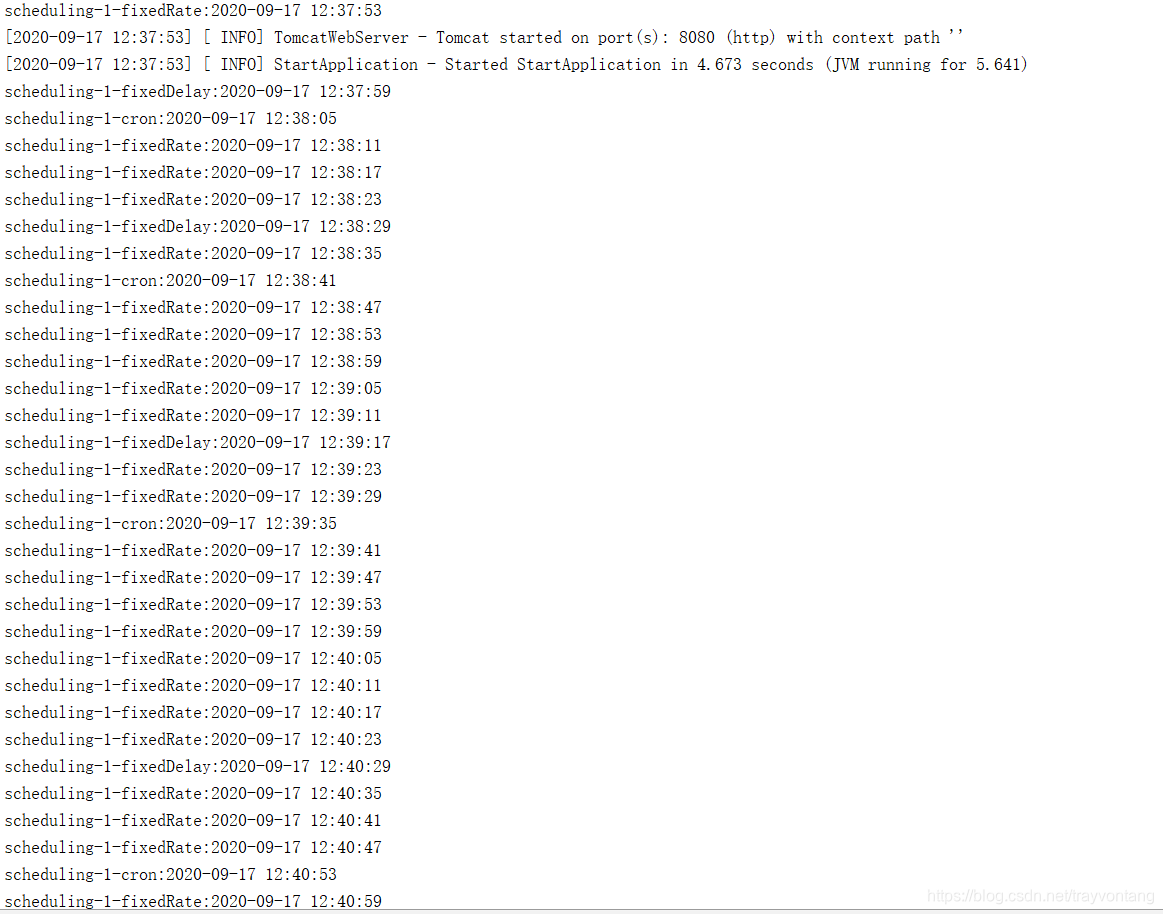- 1如何使用docker-compose.yml构建镜像?_dockercompose重新构建镜像
- 2「Unity3D」(10)自定义属性面板Inspector详解_unity propertyfield
- 3win10 Docker Desktop 换国内源 及 修改镜像位置_docker desktop 国内源
- 4强化学习 最前沿之Hierarchical reinforcement learning(一)
- 5docker-compose常用命令_docker compose down
- 6PyTorch 2.2大更新!集成FlashAttention-2,性能提升2倍
- 7Uniapp+Vue2网易云音乐微信小程序_vue 网易云应用小程序
- 82024美国大学生数学建模E题财产保险的可持续模型详解思路+具体代码_数学建模 "保险,极端天气
- 9C#的进化——C#发展史、C#1.0-10.0语法系统性梳理、C#与JAVA的对比_c#9.0 c#10.0区别
- 10度学习pytorch实战六:ResNet50网络图像分类篇自建花数据集图像分类(5类)超详细代码_迁移学习(resnet50模型实现图像分类
SpringBoot @Schedule使用注意与原理
赞
踩
简介
之前使用@Schedule一直没有遇到什么问题,那种拿来就用的感觉还挺好,最近使用@Schedule遇到一点问题,才仔细的研究了一下@Schedule的一些细节和原理问题。
这篇文章就将分享一下,使用@Schedule一些可能被忽略的问题。
注意事项
@Schedule默认线程池大小
我相信@Schedule默认线程池大小的问题肯定是被很多拿来就用的朋友忽略的问题,默认情况下@Schedule使用线程池的大小为1。
一般情况下没有什么问题,但是如果有多个定时任务,每个定时任务执行时间可能不短的情况下,那么有的定时任务可能一直没有机会执行。
有兴趣的朋友,可以试一下:
@Component public class BrigeTask { private static final DateTimeFormatter FORMATTER = DateTimeFormatter.ofPattern("yyyy-MM-dd HH:mm:ss"); @Scheduled(cron = "*/5 * * * * ?") private void cron() throws InterruptedException { System.out.println(Thread.currentThread().getName() + "-cron:" + LocalDateTime.now().format(FORMATTER)); TimeUnit.SECONDS.sleep(6); } @Scheduled(fixedDelay = 5000) private void fixedDelay() throws InterruptedException { System.out.println(Thread.currentThread().getName() + "-fixedDelay:" + LocalDateTime.now().format(FORMATTER)); TimeUnit.SECONDS.sleep(6); } @Scheduled(fixedRate = 5000) private void fixedRate() throws InterruptedException { System.out.println(Thread.currentThread().getName() + "-fixedRate:" + LocalDateTime.now().format(FORMATTER)); TimeUnit.SECONDS.sleep(6); } }
- 1
- 2
- 3
- 4
- 5
- 6
- 7
- 8
- 9
- 10
- 11
- 12
- 13
- 14
- 15
- 16
- 17
- 18
- 19
- 20
- 21
- 22
- 23
上面的任务中,fixedDelay与cron,可能很久都不会被执行。

要解决上面的问题,可以把执行任务的线程池设置大一点,怎样设置通过实现SchedulingConfigurer接口,在configureTasks方法中配置,这种方式参见后面的代码,这里可以直接注入一个TaskScheduler来解决问题。
@Bean
public TaskScheduler taskScheduler() {
ThreadPoolTaskScheduler taskScheduler = new ThreadPoolTaskScheduler();
taskScheduler.setPoolSize(5);
return taskScheduler;
}
- 1
- 2
- 3
- 4
- 5
- 6
当然也可以使用ScheduledExecutorService:
@Bean
public ScheduledExecutorService scheduledExecutorService() {
return Executors.newScheduledThreadPool(10);
}
- 1
- 2
- 3
- 4
为啥这样有效,请参考后面@Schedule原理。
固定延迟与固定速率
@Schedule的三种方式cron、fixedDelay、fixedRate不管线程够不够都会阻塞到上一次执行完成,才会执行下一次。
如果任务方法执行时间非常短,上面三种方式其实基本没有太多的区别。
如果,任务方法执行时间比较长,大于了设置的执行周期,那么就有很大的区别。例如,假设执行任务的线程足够,执行周期是5s,任务方法会执行6s。
cron的执行方式是,任务方法执行完,遇到下一次匹配的时间再次执行,基本就会10s执行一次,因为执行任务方法的时间区间会错过一次匹配。
fixedDelay的执行方式是,方法执行了6s,然后会再等5s再执行下一次,在上面的条件下,基本就是每11s执行一次。
fixedRate的执行方式就变成了每隔6s执行一次,因为按固定区间执行它没5s就应该执行一次,但是任务方法执行了6s,没办法,只好6s执行一次。
上面的结论都可以通过,最上面的示例验证,有兴趣的朋友可以调整一下休眠时间测试一下。
SpringBoot @Schedule原理
在SpringBoot中,我们使用@EnableScheduling来启用@Schedule。
@Target(ElementType.TYPE)
@Retention(RetentionPolicy.RUNTIME)
@Import(SchedulingConfiguration.class)
@Documented
public @interface EnableScheduling {
}
- 1
- 2
- 3
- 4
- 5
- 6
- 7
EnableScheduling注解没什么特殊,需要注意import了SchedulingConfiguration。
SchedulingConfiguration一看名字就知道是一个配置类,肯定是为了添加相应的依赖类。
@Configuration
@Role(BeanDefinition.ROLE_INFRASTRUCTURE)
public class SchedulingConfiguration {
@Bean(name = TaskManagementConfigUtils.SCHEDULED_ANNOTATION_PROCESSOR_BEAN_NAME)
@Role(BeanDefinition.ROLE_INFRASTRUCTURE)
public ScheduledAnnotationBeanPostProcessor scheduledAnnotationProcessor() {
return new ScheduledAnnotationBeanPostProcessor();
}
}
- 1
- 2
- 3
- 4
- 5
- 6
- 7
- 8
- 9
- 10
我们可以看到在SchedulingConfiguration创建了一个ScheduledAnnotationBeanPostProcessor。
看样子SpringBoot定时任务的核心就是ScheduledAnnotationBeanPostProcessor类了,下面我们来看一看ScheduledAnnotationBeanPostProcessor类。
ScheduledAnnotationBeanPostProcessor
public class ScheduledAnnotationBeanPostProcessor
implements ScheduledTaskHolder, MergedBeanDefinitionPostProcessor, DestructionAwareBeanPostProcessor,
Ordered, EmbeddedValueResolverAware, BeanNameAware, BeanFactoryAware, ApplicationContextAware,
SmartInitializingSingleton, ApplicationListener<ContextRefreshedEvent>, DisposableBean {
}
- 1
- 2
- 3
- 4
- 5
ScheduledAnnotationBeanPostProcessor实现了很多接口,这里重点关注2个,ApplicationListener和DestructionAwareBeanPostProcessor。
DestructionAwareBeanPostProcessor封装任务
DestructionAwareBeanPostProcessor继承了BeanPostProcessor。
BeanPostProcessor相信大家已经非常熟悉了,就是在Bean创建执行setter之后,在自定义的afterPropertiesSet和init-method前后提供拦截点,大致执行的先后顺序是:
Bean实例化 -> setter -> BeanPostProcessor#postProcessBeforeInitialization ->
-> InitializingBean#afterPropertiesSet -> init-method -> BeanPostProcessor#postProcessAfterInitialization
我们看一下ScheduledAnnotationBeanPostProcessor的postProcessAfterInitialization方法:
@Override public Object postProcessAfterInitialization(Object bean, String beanName) { if (bean instanceof AopInfrastructureBean || bean instanceof TaskScheduler || bean instanceof ScheduledExecutorService) { // Ignore AOP infrastructure such as scoped proxies. return bean; } Class<?> targetClass = AopProxyUtils.ultimateTargetClass(bean); if (!this.nonAnnotatedClasses.contains(targetClass) && AnnotationUtils.isCandidateClass(targetClass, Arrays.asList(Scheduled.class, Schedules.class))) { Map<Method, Set<Scheduled>> annotatedMethods = MethodIntrospector.selectMethods(targetClass, (MethodIntrospector.MetadataLookup<Set<Scheduled>>) method -> { Set<Scheduled> scheduledMethods = AnnotatedElementUtils.getMergedRepeatableAnnotations( method, Scheduled.class, Schedules.class); return (!scheduledMethods.isEmpty() ? scheduledMethods : null); }); if (annotatedMethods.isEmpty()) { this.nonAnnotatedClasses.add(targetClass); if (logger.isTraceEnabled()) { logger.trace("No @Scheduled annotations found on bean class: " + targetClass); } } else { // Non-empty set of methods annotatedMethods.forEach((method, scheduledMethods) -> scheduledMethods.forEach(scheduled -> processScheduled(scheduled, method, bean))); if (logger.isTraceEnabled()) { logger.trace(annotatedMethods.size() + " @Scheduled methods processed on bean '" + beanName + "': " + annotatedMethods); } } } return bean; }
- 1
- 2
- 3
- 4
- 5
- 6
- 7
- 8
- 9
- 10
- 11
- 12
- 13
- 14
- 15
- 16
- 17
- 18
- 19
- 20
- 21
- 22
- 23
- 24
- 25
- 26
- 27
- 28
- 29
- 30
- 31
- 32
- 33
- 34
- 35
简单说一下流程:
找到所有的Schedule方法,把它封装为ScheduledMethodRunnable类(ScheduledMethodRunnable类实现了Runnable接口),并把其做为一个任务注册到ScheduledTaskRegistrar中。
如果对具体的逻辑感兴趣,可以从postProcessAfterInitialization方法顺着processScheduled方法一次debug。
ApplicationListener执行任务
前面我们介绍通过BeanPostProcessor解析出了所有的任务,接下来要做的事情就是提交任务了。
@Override
public void onApplicationEvent(ContextRefreshedEvent event) {
if (event.getApplicationContext() == this.applicationContext) {
// Running in an ApplicationContext -> register tasks this late...
// giving other ContextRefreshedEvent listeners a chance to perform
// their work at the same time (e.g. Spring Batch's job registration).
finishRegistration();
}
}
- 1
- 2
- 3
- 4
- 5
- 6
- 7
- 8
- 9
ScheduledAnnotationBeanPostProcessor监听的事件是ContextRefreshedEvent,就是在容器初始化,或者刷新的时候被调用。
监听到ContextRefreshedEvent事件之后,值调用了finishRegistration方法,这个方法的基本流程如下:
- 找到容器中的SchedulingConfigurer,并调用它的configureTasks,SchedulingConfigurer的作用主要就是配置ScheduledTaskRegistrar类,例如线程池等参数,例如:
import org.springframework.context.annotation.Configuration;
import org.springframework.scheduling.annotation.SchedulingConfigurer;
import org.springframework.scheduling.config.ScheduledTaskRegistrar;
import java.util.concurrent.Executors;
@Configuration
public class MyScheduleConfig implements SchedulingConfigurer {
@Override
public void configureTasks(ScheduledTaskRegistrar taskRegistrar) {
taskRegistrar.setScheduler(Executors.newScheduledThreadPool(10));
}
}
- 1
- 2
- 3
- 4
- 5
- 6
- 7
- 8
- 9
- 10
- 11
- 12
- 13
- 14
- 调用ScheduledTaskRegistrar的afterPropertiesSet方法执行任务,如果对具体的逻辑感兴趣,可以阅读ScheduledTaskRegistrar的scheduleTasks方法。
关于为啥直接在容器中注入一个TaskScheduler、ScheduledExecutorService也可以有效,也可以在finishRegistration方法中找到答案。
- 如何实现附近商户的搜索?RedisGEO一键搞定!微服务SpringBoot整合RedisGEO实现附近商户功能文章目录⛄引言♨️广播站一、RedisGEO数据结构用法⛅GEO基本语法、指令⚡使用GEO存储经纬度、查询距离二、SpringB... [详细]
赞
踩
- 智能导诊系统按照人体的性别差异,设计了男性/女性两种3D立体模型,用于病症库与自助导诊之间数据信息的读取与交互,在软件病症库中,将不同患者的常见病症进行分类整合,患者可通过人体画像选择症状部位,了解对应病症信息和推荐就医科室,为患者提供直观... [详细]
赞
踩
- 主要功能包括管理员:首页、个人中心、图书分类管理、回收类别管理、新书榜管理、特价区管理、旧书回收管理、用户管理、订单评价管理、回收预约管理、图书回收管理、管理员管理、系统管理、订单管理。前台使用:首页、新书榜、特价区、旧书回收、公告资讯、个... [详细]
赞
踩
- 随着科学技术的飞速发展,社会的方方面面、各行各业都在努力与现代的先进技术接轨,通过科技手段来提高自身的优势,狗粮销售信息管理系统当然也不能排除在外。狗粮销售信息管理系统是以实际运用为开发背景,运用软件工程原理和开发方法,采用java技术构建... [详细]
赞
踩
- article
springBoot + netty搭建高性能 websocket 服务 & 性能测试(包含python 测试脚本)_netty websocket 和netty-websocket 性能对比
springBootnettywebsocket性能测试_nettywebsocket和netty-websocket性能对比nettywebsocket和netty-websocket性能对比一、前言1、如果我们的app类似于股票这种,数... [详细]赞
踩
- 前面是站在后台员工的角度,现在站在消费者的角度,当客户从移动端选择通过验证码登录APP,需要调用云服务器的短信功能(厂商短信服务API),后端要做的就是生成验证码并发送,并针对请求中客户收到的验证码与后端发送的进行比对,确保一致后成功登录_... [详细]
赞
踩
- 传统办法管理信息首先需要花费的时间比较多,其次数据出错率比较高,而且对错误的数据进行更改也比较困难,最后,检索数据费事费力。因此,在计算机上安装美妆购物网站软件来发挥其高效地信息处理的作用,可以规范信息管理流程,让管理工作可以系统化和程序化... [详细]
赞
踩
- 在网络信息发展时代,众多的软件被开发出来,给用户带来了很大的选择余地,而且人们越来越追求更个性的需求。在这种时代背景下,平台只能以用户为导向,按项目分类组织,以项目的持续创新作为平台最重要的竞争手段。系统采用了B/S结构,将所有模块采用以浏... [详细]
赞
踩
- 现代经济快节奏发展以及不断完善升级的信息化技术,让传统数据信息的管理升级为软件存储,归纳,集中处理数据信息的管理方式。本手机销售网站就是在这样的大环境下诞生,其可以帮助管理者在短时间内处理完毕庞大的数据信息,使用这种软件工具可以帮助管理人员... [详细]
赞
踩
- Springboot@Test给Controller接口写单元测试_controller怎么测试controller怎么测试前言最近有小伙伴问到怎么给controller的接口写单元测试。 单元测试是开发必不可少的一个环节。既然有... [详细]
赞
踩
- 需求分析:系统分析:在实际饭堂中,学生可以拿饭卡到各个窗口(终端)消费,为了安全,学生还可以修改自己饭卡的密码、查询饭卡的余额和还应该要有查询消费记录,但充值、挂失等必须到管理员处才能办理。而管理员必须能看到系统里的所有记录,还能实现充值、... [详细]
赞
踩
- Quartz是OpenSymphony开源组织在Jobscheduling领域又一个开源项目,它可以与J2EE与J2SE应用程序相结合也可以单独使用。Quartz可以用来创建简单或为运行十个,百个,甚至是好几万个Jobs这样复杂的程序。Jo... [详细]
赞
踩
- 大概了解到这个程度差不多了,如果想要深入了解还是需要掌握挺多内容的。用简单的话来总结下SpringDeferredResult:如果返回值类型是DeferredResult则表明其是异步请求,tomcat线程不会等到应用程序处理完或者超时,... [详细]
赞
踩
- 我们可以根据数据结构的详细分析要求,我们根据输入和输出数据量的要求进行分析,确定什么表表,结构之间的关系,我们可以验证,调整和完善,查询和浏览过程,可以实现数据库,以使用户对数据和功能有更多要求。基于系统使用的数据库管理系统的特点,对数据库... [详细]
赞
踩
- SpringBoot整合分布式搜索引擎如何实现ElasticSearch实现我附近的、酒店竞排?_按距离排序springboot按距离排序springboot文章目录⛄引言一、我附近的酒店⛅需求分析⚡源码编写二、酒店竞价排名⌚需求分析⏰修改... [详细]
赞
踩
- 微信小程序零食商城系统设计和实现主要功能设计:首页、网站公告、购物车、我的、零食分类、零食搜索、订单、购物车、评论、收藏、点赞、点踩、个人中心、用户充值、用户管理、零食分类管理、零食管理、系统管理、订单管理_springboot商城实战项目... [详细]
赞
踩
- 主要功能设计:首页、个人中心、用户管理、物资捐赠管理。物资申请管理、物资捐赠审核、工作信息管理、外出报备管理、投诉信息管理、体温上报管理、商品代买管理、商品配送管理、社区论坛、系统管理等功能。_item.hasfrontloginitem.... [详细]
赞
踩
- 高校资源共享交流系统主要功能设计:用户登录、注册、修改密码、首页信息展示、系统轮播图、模糊搜索、收藏、点击数量统计、点赞、点踩、评论、详情、富文本图文上传、文件上传、下载、视频上传下载、文件资料、视频资料、公告信息、留言讨论区、加上一些基本... [详细]
赞
踩
- 在线版权登记系统主要功能设计:用户登录、注册、修改密码、首页信息展示、系统轮播图、模糊搜索、收藏、版权热度点击数量统计、版权文件下载、评论、收藏、富文本图文上传、文件上传、下载、视频上传下载、版权资料、视频资料、公告信息、加上一些基本业务功... [详细]
赞
踩
- 如今社会上各行各业,都喜欢用自己行业的专属软件工作,互联网发展到这个时候,人们已经发现离不开了互联网。新技术的产生,往往能解决一些老技术的弊端问题。因为传统教学资源共享平台信息管理难度大,容错率低,管理人员处理数据费工费时,所以专门为解决这... [详细]
赞
踩





